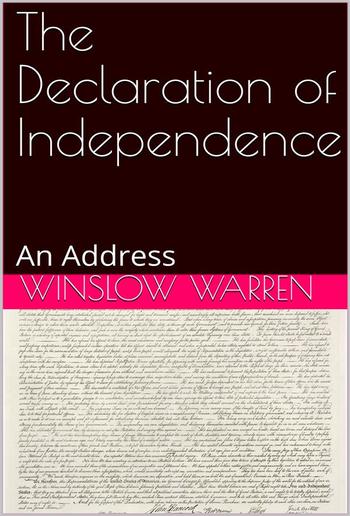
Winslow Warren - The Declaration of Independence
The Declaration of Independence
Winslow Warren
Description
The United States Declaration of Independence is the statement adopted by the Second Continental Congress meeting at the Pennsylvania State House (now known as Independence Hall) in Philadelphia, Pennsylvania, on July 4, 1776. The Declaration announced that the Thirteen Colonies at war with the Kingdom of Great Britain would regard themselves as thirteen independent sovereign states, no longer under British rule. With the Declaration, these new states took a collective first step toward forming the United States of America. The declaration was signed by representatives from New Hampshire, Massachusetts Bay, Rhode Island, Connecticut, New York, New Jersey, Pennsylvania, Maryland, Delaware, Virginia, North Carolina, South Carolina, and Georgia.
The Lee Resolution for independence was passed on July 2 with no opposing votes. The Committee of Five had drafted the Declaration to be ready when Congress voted on independence. John Adams, a leader in pushing for independence, had persuaded the committee to select Thomas Jefferson to compose the original draft of the document, which Congress edited to produce the final version. The Declaration was a formal explanation of why Congress had voted to declare independence from Great Britain, more than a year after the outbreak of the American Revolutionary War. Adams wrote to his wife Abigail, "The Second Day of July 1776, will be the most memorable Epocha, in the History of America" – although Independence Day is actually celebrated on July 4, the date that the wording of the Declaration of Independence was approved.
After ratifying the text on July 4, Congress issued the Declaration of Independence in several forms. It was initially published as the printed Dunlap broadside that was widely distributed and read to the public. The source copy used for this printing has been lost and may have been a copy in Thomas Jefferson's hand. Jefferson's original draft is preserved at the Library of Congress, complete with changes made by John Adams and Benjamin Franklin, as well as Jefferson's notes of changes made by Congress. The best-known version of the Declaration is a signed copy that is displayed at the National Archives in Washington, D.C., and which is popularly regarded as the official document. This engrossed copy (finalized, calligraphic copy) was ordered by Congress on July 19 and signed primarily on August 2.
Abraham Lincoln made it the centerpiece of his policies and his rhetoric, as in the Gettysburg Address of 1863. Since then, it has become a well-known statement on human rights, particularly its second sentence:
"We hold these truths to be self-evident, that all men are created equal, that they are endowed by their Creator with certain unalienable Rights, that among these are Life, Liberty and the pursuit of Happiness."
This has been called "one of the best-known sentences in the English language", containing "the most potent and consequential words in American history". The passage came to represent a moral standard to which the United States should strive. This view was notably promoted by Lincoln, who considered the Declaration to be the foundation of his political philosophy and argued that it is a statement of principles through which the United States Constitution should be interpreted.
The Declaration of Independence inspired many similar documents in other countries, the first being the 1789 Declaration of United Belgian States issued during the Brabant Revolution i

